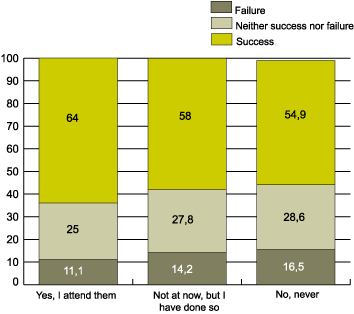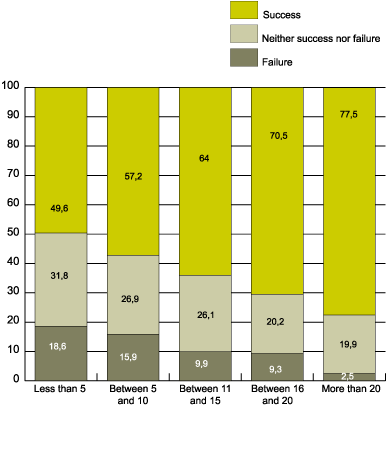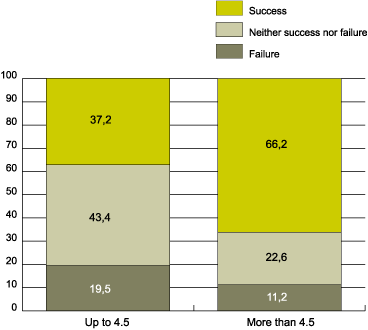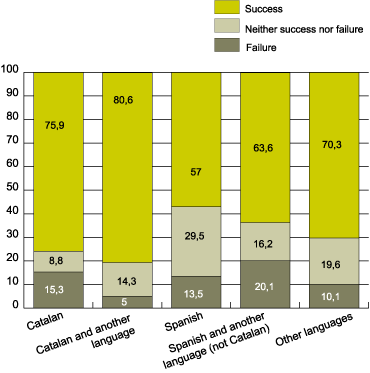
“Volunteers for language”, Linguistic Integration Programme in Catalan: facts for evaluation, by Joan Solé Camardons, Jonatan Castaño and Agustí Díaz |
||||
| CONTINUA |
Attendance at courses With regard to the relationship between learner type and attendance of Catalan courses, we see a direct relationship between success level and the fact of present attendance of such courses and there is a difference of 9 percentage points with those who have never attended such courses. Those who are ex-students of the courses are situated half way between the two. Graph 6. Type of learner and attendance at courses
Number of hours Of all variables analysed, the number of hours of study devoted to the programme is the most significant. In the case of learners who have done more than 20 hours, 77.5% fall into the “successful” category. While the percentage goes down to 64% among those who have done between 11 and 15 hours. A high degree of correlation can be seen between the number of hours dedicated to the programme and the resulting success achieved. Graph 7. Total number of hours devoted to the programme and type of learners
Ability to speak Catalan at the outset. Those who were able to speak some Catalan at the beginning of the programme were divided into two groups (against a scale of 0 to 10), taking 4.5 as the cut-off point established by segmentation tree 2 (PDF ), which is the point that best discriminates between success and failure. It can be seen that those whose ability scores are in excess of 4.5 are more likely to achieve success, (66.2% do so) than those whose ability scores are less, (only 37.2% do so). This findingpoints up the need for a basic minimum ability to speak Catalan to be able to communicate with the volunteer teacher and thus follow the course properly. Graph 8. Ability to speak Catalan at the outset
Habitual language Learners have a higher degree of successwhere they state their usual language(s) to be Catalan and one other, and in part this is due to the fact of having sufficient knowledge of Catalan to be able to follow the programme and sufficiently little Catalan to find it easy to increase their level. Those who least achieve success are those who only speak Spanish; a plausible explanation here is that while they may improve their Catalan, their speech networks typically continue to consist of Spanish speakers and so they do not increase frequency of use. Graph 9. Knowledge of Catalan at the outset
5. Learners' motivation and observations In this more qualitative part of the article, an analysis has been made of the contents of personal in-depth interviews with learners. Those interviewed were chosen according to degree of success or failure (according to learner typology, in the terms of this article) with cut-off point at 4.2. Thus an interview with a successful learner and an interview with who had failed were carried out and the content analysed to compare the two. The main findings of this content analysis are given below:
6. Factors determining the Programme's success Adopting a multimethod design for triangulation between techniques (10) we have employed two different orientations (quantitative and qualitative) to obtain knowledge about the same aspect of social reality: the success or failure of the “Volunteers for Language” programme. Below, we summarise in table form the factors that condition the success or failure of learners enroled for the programme. The factors that emerge as common to the two methodological approaches (to evaluation) that we used are:
The question of belonging to speech networks or widening existing social networks we have only been able to investigate qualitatively. This aspect has to do with favouring both sociolinguistic success (in terms of learning and use) and success in social integration. |



